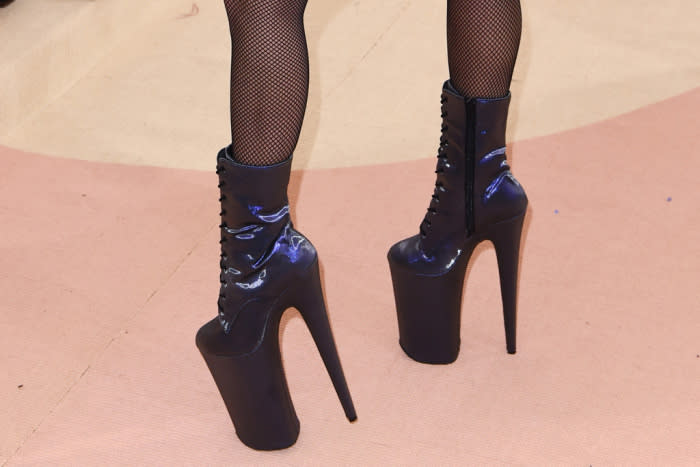A Brief History of High Heels & the Invention That Changed Fashion

More from Footwear News
Bata Shoe Museum To Open 'Art/Wear: Sneakers x Artists' Exhibition
Most Expensive Shoes: Here's What $17 Million Gets You in Footwear
What is a red carpet without high heels? Celebrities love to hit the step-and-repeat in their towering stilettos, whether in the form of closed-toe pumps, strappy sandals or sleek boots. The seemingly gravity-defying footwear lends an air of feminine power and sexuality to any ensemble, not to mention the fact that it enhances the shape the leg.
But very high heels have not always been the norm in footwear. In fact, while elevated heels date back over a millennia — and have fluctuated in terms of their popularity through the centuries — the stiletto only came into existence several decades ago, thanks to technological innovation.
To find out more about the origins of the high heel, FN reached out to noted fashion historians for their insights on the history and enduring power of this iconic footwear.
The First High Heels
Elizabeth Semmelhack, director and senior curator at the Bata Shoe Museum in Toronto, has spent years researching the history of heels, tracing them as far back as the 10th century, though she said they could date back even further in Western Asia. According to her findings, the earliest heels were used for horseback riding in Persia and their invention was tied to the creation of the stirrup.
“It is my contention that the heel was invented for horseback riding as a means of locking the foot in the stirrup,” Semmelhack said, adding that they continued to be used in Western Asia for centuries before traders brought them to Northern Europe in the 17th century, where they served a similar purpose. “Their interest in heels was spurred by new trading and political interests in Persia.”
During the 17th century, heels gradually moved beyond just horseback riding, becoming a fashion accessory that symbolized status and wealth. According to Semmelhack, the shoes were worn by both men and women until the 18th century, when “heels became the purview of women only and were given the job of proclaiming gender.”

A Game-Changing Invention
Up until the mid-20th century, shoes were most often constructed with wide, stacked heels, wedge and platform soles, which all provided a secure step for the wearer. And they frequently varied in height, depending on the reigning trends of the time.
For instance, Dr. Colleen Hill, senior curator of costume at The Museum at FIT, noted, “The platform shoes of the 1940s could sometimes feature high heels, since a platform offered stability and paired well with a chunky heel.”
But the world of high heels changed forever in the 1950s with the creation of the stiletto heel, so named because of its long, thin shape that resembled Italy’s famed dagger.
The shoes were the result of modern innovation. “Stiletto heels developed with a new technology for a thin but sturdy metal shank that allowed heels to be both tall and narrow,” said Hill, co-curator of the 2022 exhibit “Shoes: Anatomy, Identity and Magic.”
Hill noted that some have credited Salvatore Ferragamo and Roger Vivier with the “invention” of stilettos. While the true inventor is still up for debate, she acknowledges the two designers were key to its success. “They certainly popularized it, and they both created elegant, innovative designs that continue to be incredibly influential — including variations on the wedge (Ferragamo) and the kitten heel (Vivier),” she said.
For her part, Semmelhack described the stiletto as “the most game-changing heel design.”
“Made using metal, stilettos were the first heels that were both extremely high and extremely thin heels yet also capable of holding the weight of the wearer without breaking,” Semmelhack said. “There have been other important designs, but they are really [variations of] heels.”

Lasting Appeal of Heels
Even as consumer wardrobes have become more casual in recent years and sneakers have dominated the trend cycle, high heels continue to hold a vaulted place within the style lexicon.
Notable footwear designers, including Christian Louboutin, Gianvito Rossi and Amina Muaddi, explore new ways to evolve the silhouette with imaginative shapes and fresh materials and embellishments, catering to women — and men — who appreciate their unique appeal.
As designer Giuseppe Zanotti told FN in 2021, when high heels roared back following sales declines during the pandemic lockdowns, “Heels make you feel more feminine and secure sometimes. You walk differently, you act differently, everything looks more exciting when you feel beautiful and step into a room with confidence.”


How High Heels Evolved Through the Decades: From the 1920s to Today
Launch Gallery: How High Heels Evolved Through the Decades: From the 1920s to Today
Best of Footwear News
Sign up for FN's Newsletter. For the latest news, follow us on Facebook, Twitter, and Instagram.


